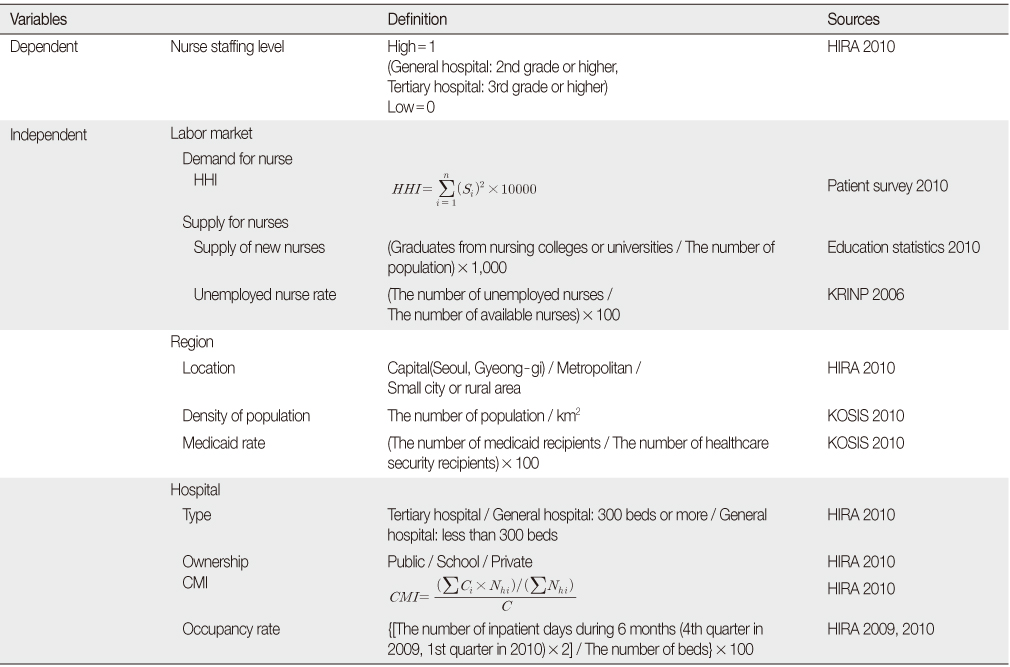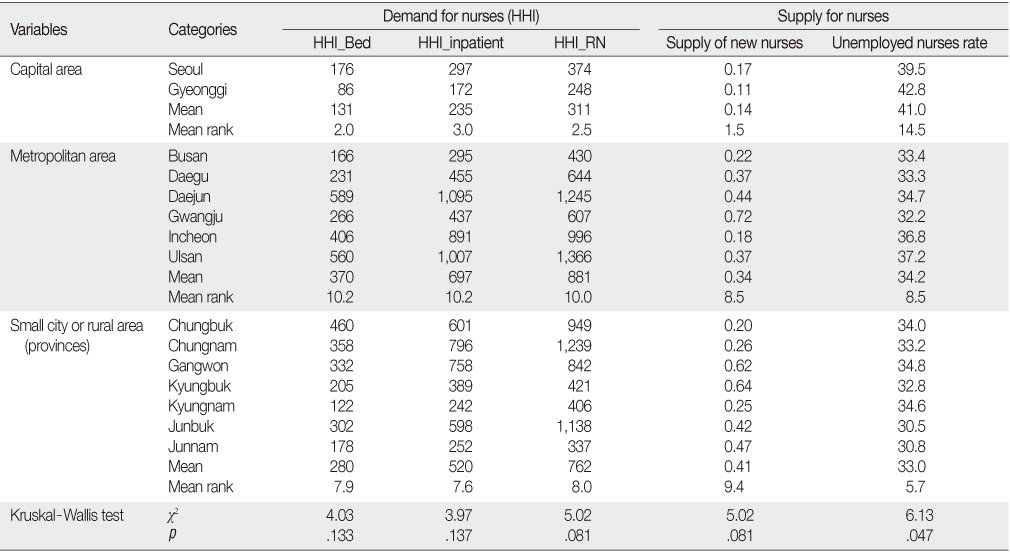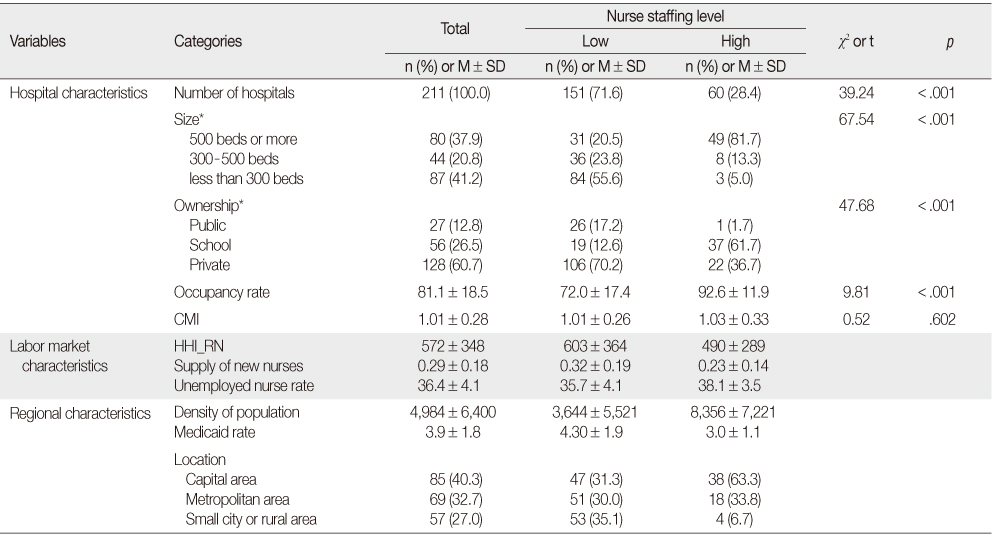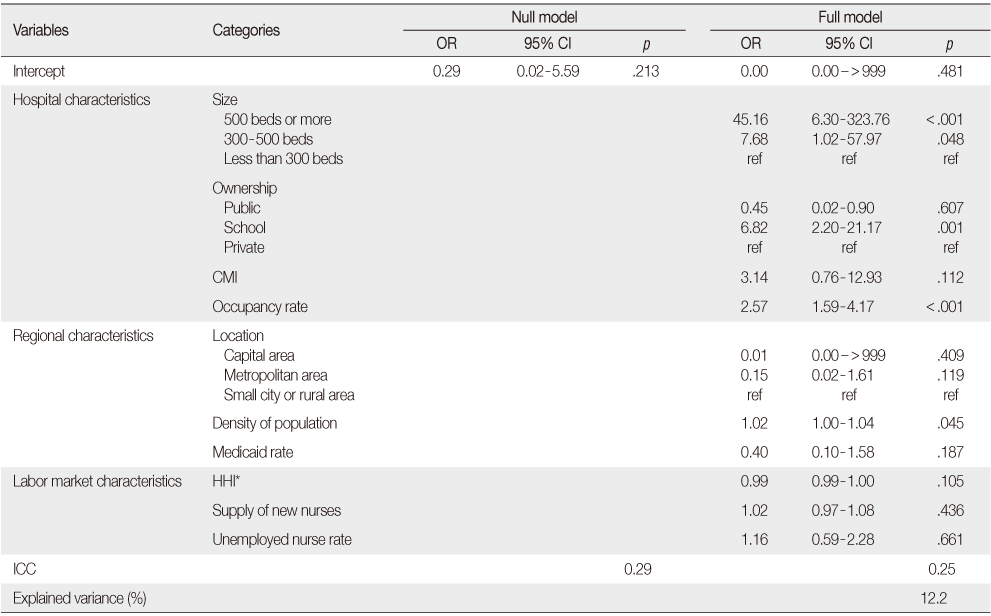Articles
- Page Path
- HOME > J Korean Acad Nurs > Volume 43(1); 2013 > Article
-
Original Article
- Structure of Nurse Labor Market and Determinants of Hospital Nurse Staffing Levels
- Bohyun Park, Sukyung Seo, Taejin Lee
-
Journal of Korean Academy of Nursing 2013;43(1):39-49.
DOI: https://doi.org/10.4040/jkan.2013.43.1.39
Published online: February 28, 2013
1Department of Nursing, Kimcheon Science College, Gimcheon, Korea.
2BK21 Center for Elderly Health Policy Research, Seoul National University, Seoul, Korea.
3Graduate School of Public Health, Seoul National University, Seoul, Korea.
- Address reprint requests to: Lee, Taejin. Graduate School of Public Health, Seoul National University, 1 Gwanak-ro, Gwanak-gu, Seoul 151-742, Korea. Tel: +82-2-880-2726, Fax: +82-2-762-9105, tjlee@snu.ac.kr
© 2013 Korean Society of Nursing Science
Figure & Data
REFERENCES
Citations

- Empirical Analysis of Geographic Inequalities in the Distribution of Nurses
Euntae Park, Jinhyun Kim
Journal of Korean Academy of Nursing Administration.2024; 30(3): 271. CrossRef - The Number of Practicing Nurses Required to Resolve Differences in Staffing Levels between Capital and Non-capital Regions and the Relationship of Regional Differences in Staffing and Salary
Sung-Hyun Cho, Ji-Yun Lee, Jinhyun Kim, U Ri Go, Jiyeong Seong
Journal of Korean Academy of Nursing Administration.2024; 30(2): 175. CrossRef - Nurses’ Intentions for COVID-19 Vaccination in South Korea in 2022
Byung Yun Song, Sun Hee Choi, Dong Yeon Kim
Journal of Korean Academy of Fundamentals of Nursing.2023; 30(1): 125. CrossRef - Integrative literature review of patient classification tools for nursing intensity evaluation: Focusing on comparison of South Korean and international tools
Yukyung Ko, Bohyun Park
Nursing Open.2021; 8(5): 2105. CrossRef - Turnover Rates and Factors Influencing Turnover of Korean Acute Care Hospital Nurses: A Retrospective Study Based on Survival Analysis
Bohyun Park, Yukyung Ko
Asian Nursing Research.2020; 14(5): 293. CrossRef - Geographic Mobility and Related Factors among Newly Graduated Nurses
Hyo Jeong Yoon, Sung Hyun Cho
Journal of Korean Academic Society of Nursing Education.2017; 23(3): 353. CrossRef - Patterns and Influential Factors of Inter-Regional Migration of New and Experienced Nurses in 2011~2015
Bohyun Park, Se Young Kim
Journal of Korean Academy of Nursing.2017; 47(5): 676. CrossRef - Influences of Burnout, Emotional labor, and Positive Psychological Capital on Job Satisfaction of Nurses
Soo Young Jun
Journal of Korean Academy of Nursing Administration.2017; 23(2): 201. CrossRef - Narrative Exploration of Infertile Nurses' Experience of Natural Abortion
Ju-Eun Hong, Jum-Mi Park
Journal of Korean Academy of Psychiatric and Mental Health Nursing.2016; 25(1): 58. CrossRef - Factors influencing the intent to return to practice (work) of inactive RNs
Nami Hwang, Insun Jang, Eunjun Park
Journal of the Korean Data and Information Science Society.2016; 27(3): 791. CrossRef - Hospital preferences of nursing students in Korea: a discrete choice experiment approach
Bo-hyun Park, YuKyung Ko
Human Resources for Health.2016;[Epub] CrossRef - A Path Analysis of Variables Influencing customer orientation of Hospital Nurses
Eun-Su Do, Young-Sook Seo
Journal of Digital Convergence.2016; 14(1): 275. CrossRef - Impact of a financial incentive policy on Korean nurse staffing
Y. Kim, J. Kim
International Nursing Review.2015; 62(2): 171. CrossRef - Study on Factors Associated with the Rise in Grade of Nursing Management Fee among Korean Hospitals
Hyun-Min Choi, Nam-Kyung Han, Sang-Kyu Lee, Han-Sung Kim, Sungkyoung Choi, Woojin Chung
Health Policy and Management.2015; 25(1): 40. CrossRef - Mediation Effect of Nursing Competency between Transformational Leadership and Organizational Commitment of Nurses in Hospitals
Young-Sook Seo, Yu-Lim Son, Chu-Young Jung
Journal of Korean Clinical Health Science.2015; 3(3): 419. CrossRef - Issues and Challenges of Nurse Workforce Policy: A Critical Review and Implication
Taewha Lee, Kyeong Hwa Kang, Yu Kyung Ko, Sung-Hyun Cho, Eun-Young Kim
Journal of Korean Academy of Nursing Administration.2014; 20(1): 106. CrossRef
Definition of Variables and Data Sources
Note: Capitalize all of the above names.
HIRA=Healthcare insurance review & assessment service; HHI=Herfindahl Hirshman index; KRINP=The Korean research institute for nursing policy; KOSIS=Korean statistical information service; CMI=Case mix index.
Demand and Supply for Nurses by Region
HHI=Herfindahl Hirshman index; RN=Registered nurse.
Wage of Nurses by Hospital Characteristics
*10,000 won/year; **Duncan grouping: a>b, c>d; †General hospital: 1st-2nd grade, Tertiary hospital: 3rd grade or higher; ‡General hospital: 3rd-5th grade, Tertiary hospital: 4-6th grade.
Hospital and Environmental Characteristics by Nurse Staffing Level
*Fisher's exact test; CMI=Case mix index; HHI=Herfindahl Hirshman index; RN=Registered nurse.
Determinants of Hospital Nurse Staffing Levels (Dependent variable: High nurse grade)
OR=Odds ratio; CMI=Case mix index; HHI=Herfindahl Hirshman index; ICC=Intraclass correlation.
*HHI was calculated on the basis of hospital's nurse share in their labor market(HHI_RN).
Note: Capitalize all of the above names. HIRA=Healthcare insurance review & assessment service; HHI=Herfindahl Hirshman index; KRINP=The Korean research institute for nursing policy; KOSIS=Korean statistical information service; CMI=Case mix index.
HHI=Herfindahl Hirshman index; RN=Registered nurse.
*10,000 won/year; **Duncan grouping: a>b, c>d; †General hospital: 1st-2nd grade, Tertiary hospital: 3rd grade or higher; ‡General hospital: 3rd-5th grade, Tertiary hospital: 4-6th grade.
*Fisher's exact test; CMI=Case mix index; HHI=Herfindahl Hirshman index; RN=Registered nurse.
OR=Odds ratio; CMI=Case mix index; HHI=Herfindahl Hirshman index; ICC=Intraclass correlation. *HHI was calculated on the basis of hospital's nurse share in their labor market(HHI_RN).
 KSNS
KSNS
 E-SUBMISSION
E-SUBMISSION





 Cite
Cite

